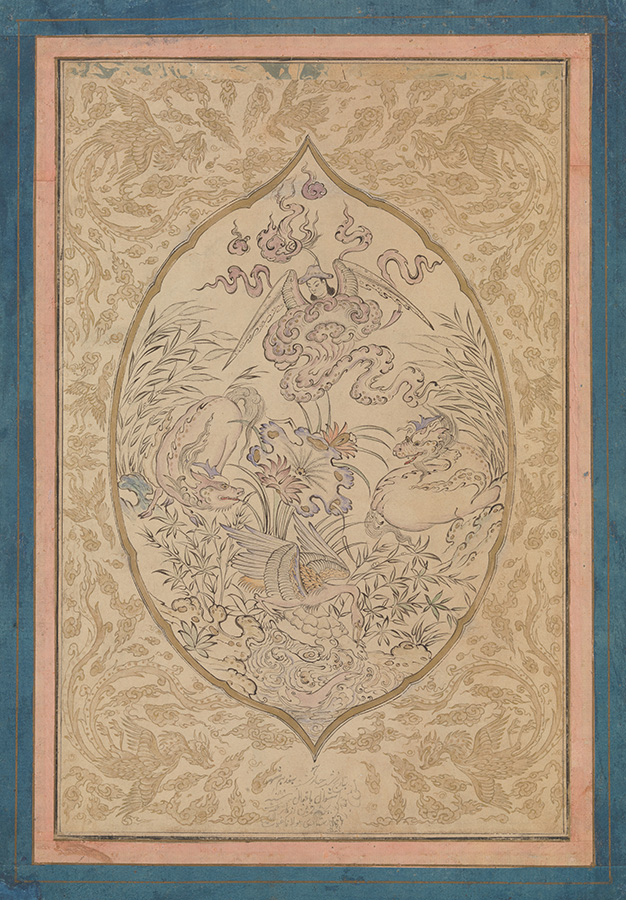Moʿin Moṣavver | Individual Drawings and Paintings
Drawing 1677.2
A Gathering of Mystical Creatures Around a Lotus Leaf
Location: The Metropolitan Museum of Art, New York, 2016.715.
Gift of William and James Morton in memory of their brother Sandy Morton, Persian Scholar and Collector, 2016.
Drawing: Ink and light watercolor on paper. 26 cm H x 17.1 cm wide. Page: 39.4 cm H x 27.3 cm W.
Signature: Signed and dated 1088/1677.
Inscription
At the bottom center, reads: hu! betāriḵ-e šab-e čahār šanba heftdahom-e šahr-e šavvāl ba eqbāl sana 1088 bejahat-e tamrin az kār-e hazrat ostādi molānā ghiāseddin. mašq-e man mobārāk bad ... moʿin-e moṣavver.
Translation: “God! Copied on the evening of Wednesday, the seventeenth of the lucky month of Shavvāl of the year 1088/2 December 1677, out of respect for my master/mentor(?) Molānā Ghiāseddin, ... Moʿin Moṣavver."
Description:
An angel, two dragon-like creatures, and a goose riding a tortoise are drawn in the calligraphic style of Moʿin, in black ink with touches of color, within an oval with pointed ends. This is in turn is contained within a ruled frame filled with vines and birds, executed in a gold or ochre color. The ochre outlined rendering on the beige colored paper is monochromatic in appearance.
Bibliography:
Christies London, 21 April 2016, Lot 105.
The Metropolitan Museum of Art, New York, 2016.715. online catalog entry
Commentary:
The word ostādi in the inscription is open to various interpretations. The primary meaning is master or teacher, implying a formal student /teacher relationship. Reżā was Moʿin's ostād. Who then was Molānā Ghiāseddin? Was he a contemporary of Moʿin, or an historical figure, or even a real person -- we do not know - so it is difficult to define the relationship. We do know from the Metropolitan Museum catalog entry that the drawing is a copy of a page from an early 15th century album, containing similar material, that is now in the Staatsbibliothek in Berlin [no further references given]. We also know that Moʿin's interest in wild and fantastic imaginary animals of all sorts peaked in the 1670's. It may have been sparked when he heard about the boy who was attacked by a tiger, an event that impacked him emotionally (cf. 1672.1). But his interest also included lions (1672.2 and 1676.1), farm animals (1676.2 and 1676.5), and birds (1684.1 and 1689.1). It is only in 1676 that Moʿin's predilection for the unusual or fantastic seems to emerge with the Man Attacked by Two Dragons (1676.4). It continues thereafter with other variations that might have been inspred by Sufi content. It is apparent not only in this drawing, but also a slightly later A Circle of Sufi Boys (1678.3), and perhaps The Lion wit Four Bodies and One Head (1677.1)
Photo courtesy of The Metropolitan Museum of Art, New York.
Robert Eng
Last Updated: July 21, 2019 | Originally published: July 21, 2019
Drawing 1677.2
A Gathering of Mystical Creatures Around a Lotus Leaf
Location: The Metropolitan Museum of Art, New York, 2016.715.
Gift of William and James Morton in memory of their brother Sandy Morton, Persian Scholar and Collector, 2016.
Drawing: Ink and light watercolor on paper. 26 cm H x 17.1 cm wide. Page: 39.4 cm H x 27.3 cm W.
Signature: Signed and dated 1088/1677.
Inscription
At the bottom center, reads: hu! betāriḵ-e šab-e čahār šanba heftdahom-e šahr-e šavvāl ba eqbāl sana 1088 bejahat-e tamrin az kār-e hazrat ostādi molānā ghiāseddin. mašq-e man mobārāk bad ... moʿin-e moṣavver.
Translation: “God! Copied on the evening of Wednesday, the seventeenth of the lucky month of Shavvāl of the year 1088/2 December 1677, out of respect for my master/mentor(?) Molānā Ghiāseddin, ... Moʿin Moṣavver."
Description:
An angel, two dragon-like creatures, and a goose riding a tortoise are drawn in the calligraphic style of Moʿin, in black ink with touches of color, within an oval with pointed ends. This is in turn is contained within a ruled frame filled with vines and birds, executed in a gold or ochre color. The ochre outlined rendering on the beige colored paper is monochromatic in appearance.
Bibliography:
Christies London, 21 April 2016, Lot 105.
The Metropolitan Museum of Art, New York, 2016.715. online catalog entry
Commentary:
The word ostādi in the inscription is open to various interpretations. The primary meaning is master or teacher, implying a formal student /teacher relationship. Reżā was Moʿin's ostād. Who then was Molānā Ghiāseddin? Was he a contemporary of Moʿin, or an historical figure, or even a real person -- we do not know - so it is difficult to define the relationship. We do know from the Metropolitan Museum catalog entry that the drawing is a copy of a page from an early 15th century album, containing similar material, that is now in the Staatsbibliothek in Berlin [no further references given]. We also know that Moʿin's interest in wild and fantastic imaginary animals of all sorts peaked in the 1670's. It may have been sparked when he heard about the boy who was attacked by a tiger, an event that impacked him emotionally (cf. 1672.1). But his interest also included lions (1672.2 and 1676.1), farm animals (1676.2 and 1676.5), and birds (1684.1 and 1689.1). It is only in 1676 that Moʿin's predilection for the unusual or fantastic seems to emerge with the Man Attacked by Two Dragons (1676.4). It continues thereafter with other variations that might have been inspred by Sufi content. It is apparent not only in this drawing, but also a slightly later A Circle of Sufi Boys (1678.3), and perhaps The Lion wit Four Bodies and One Head (1677.1)
Photo courtesy of The Metropolitan Museum of Art, New York.
Robert Eng
Last Updated: July 21, 2019 | Originally published: July 21, 2019
